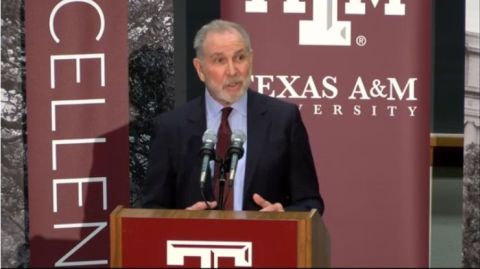
The 140th year of Texas A&M University was the theme of President Michael Young’s state of the university speech.
Tuesday’s address in the Arthur E. Martell Lecture Hall of the Chemistry Building detailed what Young called “three strategic imperatives”…transformational learning, discovery and innovation, and the impact on the state of Texas, the nation, and the world.
Young went off script to thank Karan Watson for her work as Provost. Dr. Watson, who is stepping down from that position at the end of the academic year, received a standing ovation.
Click below for comments from Michael Young:
Click HERE to read the full text of President Young’s speech.

News release from Texas A&M:
Texas A&M University is in great shape, but it will be in even better shape going forward, declared President Michael K. Young in delivering his “state of the university” address on its 140th birthday Tuesday (Oct. 4) and announcing three strategic imperatives to underscore his vision for its future.
He said short- and long-term strategies for the university will focus on three strategic imperatives: transformational learning, discovery and innovation, and impact—impact on the state, nation and world.
President Young also announced the allocation of $2 million for use during the current academic year for grants for interdisciplinary and multidisciplinary programs that can impact the university’s students in a “transformative way.”
“We want 100 percent of our students to have multiple transformational learning experiences during their time at Texas A&M University,” he emphasized.
He said he was establishing the $2 million grant program “in the spirit of hastening momentum on the call-to-action to grow transformational learning opportunities.”
Additionally, Young announced the establishment of a “Raising the Bar” working group to address structural barriers, identify funding streams and evaluate criteria for enhanced operations throughout the university – and he invited suggestions.
“Until we do that, we will continue to have great one-off successes while limiting our ability to take advantage of great strengths and continue a path to excellence,” observed the 25th president of Texas A&M.
He said the “Raising the Bar” group “will create a culture of expecting the very best of our faculty, staff and students each and every day.” He said the new initiative will entail examining how to better design budgets and funding streams and assessing space allocations.
Young emphasized early in his remarks that “the state of the university is great.”
“Our student body is more diverse than ever, more than 66,000 strong,” he said, and, particularly addressing faculty members in attendance at the ceremony, he spoke about the university’s commitment to research and support for it.
“Research funding surpassed $866 million in the last year, spurred on by many of you and the hard work you do, enhanced by the Chancellor’s Research Initiative and further grown by the Governor’s University Research Initiative, which itself added tens of millions of dollars in funding.” He referred to special research funding support provided by The Texas A&M University System Chancellor John Sharp and Governor Greg Abbott.
Delving into the university’s “transformational learning” imperative, Young explained that it has three dimensions: psychological—changes in understanding of the self; convictional—honing one’s belief systems; and behavioral—changes in lifestyle.
“The result is a new perspective of one’s place in the world,” he stated. “We have a distinct advantage in this already at Texas A&M University—an ethos that traces its roots to our founding as a land-grant institution. We are people first connected to the land, literally grounded, who have always sought, and seek today, to serve others. In fact, no university with which I have been affiliated in my career reaches the heights of the spirit of dedication and service like this university.”
He challenged faculty and students alike to “foster an increased number of transformational learning experiences”—including study-abroad experiences.
Turning to the “discovery and innovation” imperative, Young said it’s an area about which he thinks often.
He questioned: “How are we effectively utilizing the more than $866 million entrusted to us in the last year? What barriers are in place that need to be removed to unlock the greatest potential in all of us? How are we optimizing not just our processes but also our imaginations?”
Regarding impact, he cited many initiatives already underway on the state level:
· the work of the Center for Urban School Partnerships through the College of Education and Human Development
· the first-responders in the Veterinary Emergency Team during national disasters
· the Colonias Project in which the College of Architecture supports Texas border communities in need
· the College of Dentistry with an emphasis on training dentists who come from underserved areas, many of whom return to such locales
· and the School of Law, which has implemented a record number of clinics serving clients in need of help and, in the process, gaining transformational learning experiences.
“Building upon our strategic imperatives of transformational learning and discovery and innovation are the results of a job well done—impact,” he said, adding “impact on the State of Texas, the citizens of which invest in our ability to be here, impact upon the nation and impact upon the world.”
He cited more examples.
“On the national and global levels, we’re seeing tremendous impact in disease mitigation and eradication through preeminent research, mitigation and treatment of epidemics such as the pervasive Zika Virus through a multidisciplinary approach that crosses our colleges and system agencies,” Young said.
Also, he noted the strides being made in food and water access and stability research by the College of Geosciences in South and Southeast Asia to better understand and lessen contaminants as well as naturally occurring arsenic. Additionally he pointed to the Nuclear Security Science & Policy Institute, a multidisciplinary organization that spans across the Colleges of Engineering and Science and the Bush School of Government and Public Service which is committed to helping safeguard nuclear materials and reduce nuclear threats.
“I pledge to you today to work collaboratively toward impact, and I’m asking you again, on this quadrasquicentennial anniversary of the birth of our school to commit to stronger, more creative collaboration as we all continue our collective drive towards significant impact on the state, nation and world in which we live,” President Young concluded in addressing those assembled and representing all aspects of the university community.
Texas A&M, Texas’ first public institution of higher learning, opened its doors for classes on Oct. 4. 1876.
